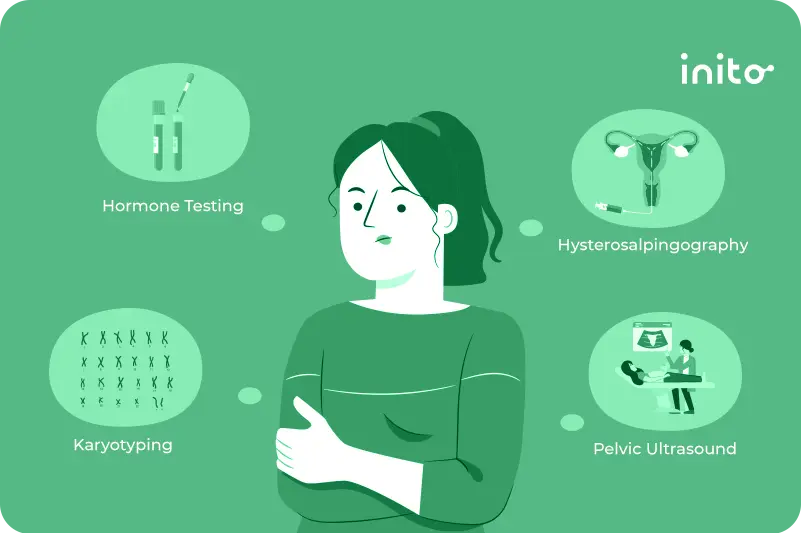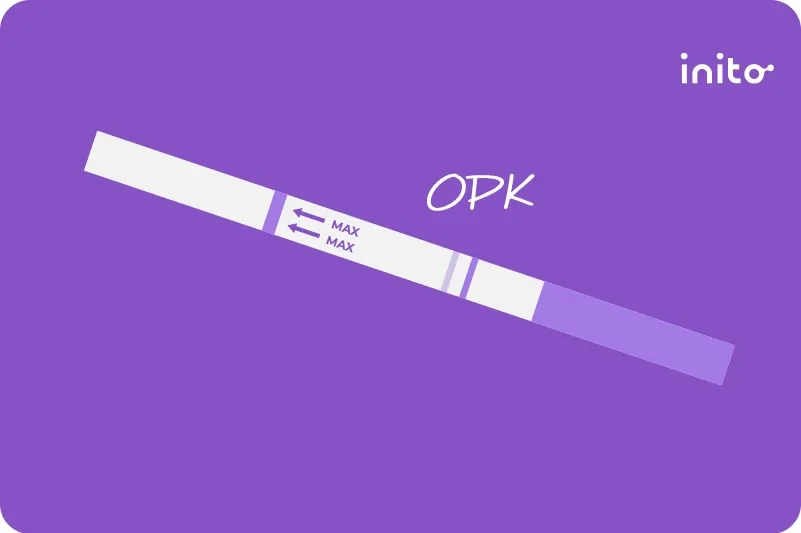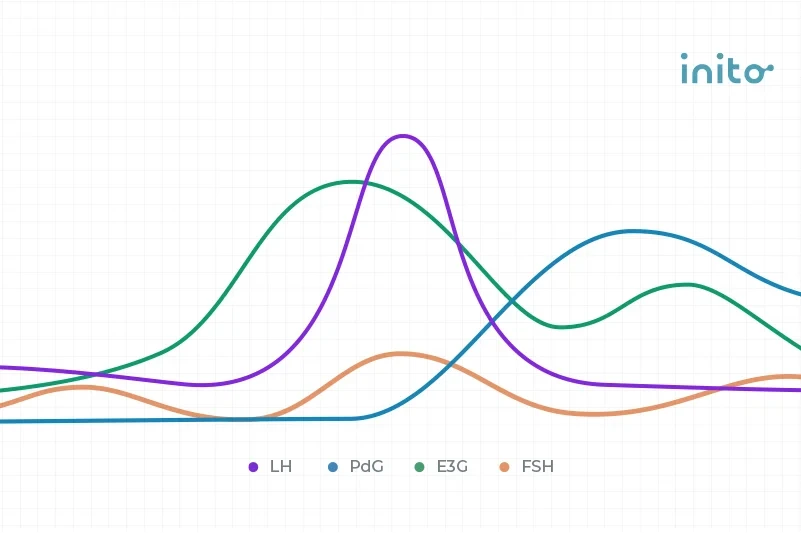Content table
What’s something that is often a huge part of the TTC journey but rarely talked about? Fertility tests for women.
Understanding these tests and your fertility is key to getting pregnant.
However, we know that talking about fertility isn’t always easy. So, we’ve created this safe space for you to learn more about fertility and how you can test yourself.
Let’s explore the world of fertility tests together so you can learn more about your current stage in the fertility journey.
Key Takeaways
- Women’s fertility tests are crucial to understanding reproductive health and successful conception.
- Infertility means more than one year of TTC for women under 35 or six months of TTC for women over 35.
- Get fertility tests if you’re struggling to conceive or have irregular periods, painful periods, a history of miscarriages, fertility issues, or have undergone chemo/radiation.
- Various conditions can lead to issues with fertility that require different types of fertility tests.
- Common fertility tests include routine blood tests, hormone tests, ultrasound, and SIS.
- At-home fertility testing options include ovulation predictor kits, the Inito Fertility Monitor, and finger-prick tests.
What Do “Fertility” and “Infertility” Mean?
Fertility refers to the ability to conceive a child. So, you are considered fertile if you can have a child.
Whereas an infertility diagnosis is given to a woman under the age of 35 who has been trying to conceive for more than a year but hasn’t had success. If you are over the age of 35, then infertility is defined as TTC for 6 months without success.
The more you learn about infertility, the more doors you open to potentially solving your issue.
This includes learning about one of the leading causes of infertility – anovulation. About 30% of women deal with infertility because of anovulation (when an egg isn’t released).
Hormonal imbalances can often lead to anovulation, which impacts your chances of conceiving.
So, how do you know if you’re a fertile female? Well, the best way to know is with a successful conception.
And if you’re facing conception challenges or menstrual irregularities, it’s time to consider female fertility testing.
Let’s get into it.
Who Needs to Take Fertility Tests?
Fertility tests are best for women who have been TTC but haven’t been able to conceive. The most common groups of women who experience this (and thus require fertility testing) include those who are:
- Aged 35 or younger who have experienced more than 1 year of TTC without success
- Over the age of 35 who have experienced more than 6 months of TTC without success
- Over the age of 40 and TTC
- Having irregular periods
- Experiencing very painful periods
- Having a history of multiple miscarriages
- Having a history of fertility issues
- Undergoing or have undergone radiation and/or chemo treatment
What Tests Check Female Fertility?
If you’re wondering what tests are done to check female fertility, you’re in the right place. Different tests are done to determine how different stages of your menstrual cycle might affect your fertility.
Below is a quick overview of the tests for your reference. Then we will give you the full scoop on each step and corresponding test(s).
|
Step of conception |
Associated conditions |
Tests |
|
Egg/follicle formation/production |
Primary ovarian insufficiency, Scarring of ovarian tissue (repeated surgeries, multiple cysts, infections) |
FSH, AMH, antral follicle count, genetic testing, USG, laparoscopy, MRI |
|
Ovulation |
Anovulation (PCOS, thyroid disorders, hyperprolactinemia, underweight, eating disorders) |
FSH, LH, estradiol, GnRH, testosterone, glucose tolerance test, lipid profile, prolactin levels, follicular scan, thyroid profile |
|
Fertilization |
Fallopian tube blockage (Endometriosis, infections, previous surgery – adhesions) |
HSG, Laparoscopy, MRI |
|
Implantation |
Uterine/cervical anomalies, low progesterone (LPD, menopause, PCOS) |
HSG, SIS, Hysteroscopy, MRI, Progesterone levels |
|
One or all of the above |
1. Endometriosis 2. Unexplained infertility |
Ultrasound, MRI, Laparoscopy |
Step 1: Egg and Follicle Formation
In a healthy body, the pituitary gland releases follicle-stimulating hormone (FSH) at the start of the menstrual cycle.
This hormone prompts multiple follicles on your ovary to grow. The largest one becomes the dominant follicle, which is home to the star of the show: the egg.
However, there are some conditions that can cause this step to not run quite so smoothly.
Primary Ovarian Insufficiency (POI)
POI happens when the ovarian follicles stop working properly before the age of 40.
This can be due to depletion or dysfunction of the egg and follicle supply or lower estrogen production in the ovaries.
Causes. Primary ovarian insufficiency may be due to chromosomal abnormalities, fragile X syndrome, or chemo and/or radiation therapy.
Tests. To test for this condition, you want to start by checking your ovarian reserve. Here are a few ways to do that.
1. Test FSH levels.
HIGH FSH LEVELS | Not enough ovarian follicles |
LOW FSH LEVELS | Follicles are not getting the stimulation they need |
2. Test Anti-Mullerian hormone (AMH) levels.
This hormone is produced by the ovarian follicles you develop. Anti-Mullerian hormone tests roughly estimate how many eggs you have left in your body.
HIGH AMH LEVELS | High egg supply (but if AMH is too high, it may mean you have PCOS) |
LOW AMH LEVELS | Decreased ovarian function |
3. Test antral follicle count.
A pelvic ultrasound shows how many small follicles you have in your ovaries. This is important in predicting fertility.
Testing this count, along with AMH and FSH testing, gives you the most accurate fertility results.
4. Test genetics.
Does your family have a history of primary ovarian insufficiency? Then it’s advisable to get genetic testing for related disorders.
Scarring of ovarian tissue
If you have undergone multiple surgeries or have had multiple cysts or infections, your ovarian tissue may be scarred. This can affect your fertility.
Tests. The best way to test for scarred ovarian tissue is with an ultrasound, MRI, or laparoscopy.
Step 2: Ovulation
Now that the egg is prepped, you’re ready for step two: ovulation.
Ovulation is the time in your cycle when your egg gets released from the follicle. This happens thanks to a surge in Luteinizing Hormone (LH).
Unfortunately, some conditions can derail this process.
Anovulation
This happens when your body does not ovulate, a.k.a. when an egg isn’t released from your ovaries during your cycle.
Causes. As the #1 leading cause of infertility, anovulation can be the result of issues such as:
- PCOS
- Thyroid disorders
- Hyperprolactinemia
- Underweight
- Overweight
- Eating disorders
Tests. There are a few ways you can check for ovulation.
1. Blood tests.
These tests will read your GnRH, FSH, LH, and estradiol levels to determine whether you’re ovulating.
2. Testosterone, glucose tolerance, and lipid profile tests.
These tests are done since PCOS is associated with:
- Higher androgen levels
- Insulin resistance
- Higher risk of lifestyle-related diseases
3. Prolactin levels test.
High prolactin levels affect FSH, LH, and, as a result, ovulation.
4. Follicular scan.
If any of these apply to you, you want to get a follicular scan:
- FSH therapy
- History of miscarriages
- Irregular cycles
This scan checks the size of the follicle to tell you if and when you’re going to ovulate.
Step 3: Fertilization
Now that the egg has been released, what happens next?
It embarks on its journey to the fallopian tube, where it links up with the sperm, and *boom,* fertilization happens!
But, it’s not always that simple – some conditions can get in the way.
Fallopian tube blockage
Yep, this is exactly what it sounds like – the fallopian tubes get blocked, so they can’t do their job correctly. You can imagine that makes fertilization quite difficult.
Causes. This blockage can be a result of:
- Endometriosis
- Infections
- Previous surgery
Tests. Here are the top ways to check for fallopian tube blockage.
1. HSG (hysterosalpingography)
This x-ray procedure is used to find any abnormalities in the uterus and fallopian tubes. It’s performed by injecting radiopaque dye into the blood so that it’s easier for the doctor to see the uterus or fallopian tubes.
2. SHG or SIS (sonohysterogram)
This is similar to the HSG but uses sterile saline water instead of the radiopaque dye and ultrasound instead of an x-ray to take a look at the uterus and fallopian tubes.
The saline solution is infused inside the uterus, and the ultrasound is put in through the vagina to see inside the fallopian tubes and uterus.
3. Laparoscopy
This is a minimally invasive procedure. A scope (a tube with a camera at one end) is used to check in on the key parts of the reproductive system, including the fallopian tubes, ovaries, and the uterus.
4. Laparotomy
This is a surgery (not done very often) where the surgeon cuts you open to examine your fallopian tube and figure out where things went wrong.
5. MRI scan
An MRI can be helpful in looking deeper at potential blockages in the fallopian tubes.
Step 4: Implantation
Well, fertilization has happened, and now we move on to implantation.
Implantation is when the embryo takes its journey to the uterus and finds a home in the endometrium. This typically happens 8-10 days past ovulation (DPO).
Unfortunately, some conditions can keep this key step from happening.
Uterine or cervical anomalies
These can mess with the location of implantation and also increase the risk of ectopic pregnancies. Some of these anomalies are:
- Uterus didelphys (also called a double uterus)
- Unicornuate uterus (only one half of the uterus is present)
- Bicornuate uterus (heart-shaped uterus)
- Arcuate uterus (uterus with a dent in the top)
- Septate uterus (uterus with a partition (or “septum”) in the middle)
- Absent uterus
Tests. Here’s how to best test for uterine anomalies.
1. HSG.
As a reminder, HSG is an x-ray that uses dye to see the uterus or fallopian tubes more clearly.
2. SHG/SIS.
Quick refresh here, too: This procedure is akin to the HSG, but uses sterile saline water and an ultrasound instead.
3. Hysteroscopy.
This procedure is rare, but it uses a hysteroscope to go in through the vagina and cervix to take a look at the uterus. It doesn’t involve any cuts.
4. MRI scan.
This scan can help doctors get a better look at any uterine abnormalities.
Low progesterone levels
If your progesterone is low, that can also wreak havoc with implantation. Low progesterone can increase your risk of miscarriage and an ectopic pregnancy.
Causes: Here are some of the reasons you may be experiencing low progesterone levels:
- Luteal phase defects
- Menopause
- Anovulation
- Stress
- PCOS
- Weight issues: Overweight or underweight
Tests. The most common way to test your progesterone levels is with a blood test.
Are There Other Tests to Take for Fertility?
In addition to the above tests that may be applicable to you, you also want to stay on top of your general health checkup that can keep your overall health in tip-top shape to make your body more able to conceive successfully.
Here’s what your doctor will test in your general women’s health checkup:
- Physical exam
- Complete blood count to give you a baseline (to check for anemia, infections, clotting disorders, etc.)
- Thyroid function (T3, T4, and TSH to check for thyroid disorders)
- STIs
- Pap smear (To test for cervical cancer. This is something you should get every year if you’re over the age of 30.)
What Other Conditions Are Associated With Female Infertility?
Though we went through quite a bit above in regards to what may be causing female infertility, there are a couple more things we wanted to chat about.
Endometriosis
Did you know that 10-15% of women who are childbearing age suffer from the symptoms of endometriosis? So, if this is you, know that you’re not alone.
Not sure what endometriosis is? We’ve got you covered.
It means that you have uterine tissue that forms outside of your uterus. This can result not only in some serious menstrual cramps but can also affect your fertility.
How?
Well, because endometriosis can cause the following:
- Pain during sex
- Ovarian cysts
- Adhesions
- Negative effect on egg quality
And those things can cause all of the above steps we shared to fall out of, well, step. And that can lead to fertility issues.
Learn more about endometriosis with our 411 on the condition: Your Guide to Getting Pregnant With Endometriosis
Unexplained Infertility
Sometimes there are just no known reasons why infertility is happening despite the fact that the tests are normal.
What’s a normal range vs. a diagnostic range for fertility tests?
With all this talk about testing, it’s important to know what “normal” ranges are for LH, FSH, progesterone, etc., and when levels might signal a concern.
TEST | NORMAL RANGE (in blood) | DIAGNOSTIC RANGE |
FSH | Follicular Phase
Luteal Phase
| If FSH>30-40, repeat the test after one month; if it is still >30-40
|
LH | Follicular Phase
Luteal Phase
| Higher than the normal range
|
1:1 to 2:1 | ≥2
| |
Estradiol | ||
Testosterone |
| |
Progesterone |
Ovulation
Luteal phase
Post-menopausal
Pregnancy
| Less than the values to the left
|
AMH | 2.2–6.8 ng/ml in any phase of the cycle | 0.3-2.2
<0.3
>6.8
|
Glucose tolerance test | At 2 hours blood sugar <140 mg/dl | 140 to 199 mg/dL
200 mg/dL or higher
|
Lipid profile | Total cholesterol
HDL
LDL
Triglycerides
| Hypercholesterolemia (outside this range) |
TSH | >4.5 + low T4
<0.1 + elevated T3 or T4
| |
Prolactin | 5-25 ng/ml |
|
How Do You Test Female Fertility at Home?
A lot of this info about women’s fertility tests may be new to you. So if you’re wondering “Is there a way to test female fertility at home?”, the answer is YES!
Here are your options for at-home fertility hormone testing.
Ovulation Predictor Kits (OPKs)
These are at-home urine tests that help you predict ovulation by measuring your urine LH levels.
However, we want to bring to your attention some key issues with OPKs.
Problem #1. Many tests only check for alpha LH, not beta LH. This can lead to false results because alpha LH may react with FSH, hCG, and TSH.
Problem #2. They are only useful if you fall in the range of “normal” values (like we shared in the chart above). If you fall outside of those ranges, then OPKs are not going to be accurate.
Problem #3. They predict ovulation but can’t actually confirm it. Why? because they don’t measure your progesterone metabolite PdG levels.
So, is there an easy way to check fertility? The Inito Fertility Monitor is an at-home test for women. It measures FSH, alpha and beta LH, estrogen, PdG (urine metabolite of progesterone) levels on a single strip to track and confirm ovulation. Instead of ranges, Inito gives precise numerical values.
Why is this important?
Because it means the test is accurate even for irregular cycles, PCOS, or anovulatory cycles.
Blood testing
Testing for your hormones through finger-pricking is also easy to do at home but can be painful and scary to do on your own. On top of that, this at-home fertility testing method is still not as accurate as lab tests.
When Should You Take an At-Home Women’s Fertility Test?
Fertility tests aren’t for everyone, but they can make a world of difference to some.
Here are the best circumstances to use an at-home fertility test.
- If you’re TTC and want to know where your hormones are at and when your fertile window is.
- If you’re in the window of time where you can’t go to the doctor quite yet.
- If you’re looking for a women’s fertility testing option that is easier, more affordable and avoids repeated visits to the doctor.

FAQs
There are a lot of tests that check different parameters related to female fertility. For example, there are tests that give a glimpse into follicle production, ovulation, implantation, and fertilization. These tests can include everything from blood tests to check for levels of specific hormones to more involved procedures like an MRI or hysteroscopy. The exact female fertility tests you’ll need done are determined by your specific fertility challenges.
Fertility specialists and doctors can run a variety of diagnostic tests and procedures to see if a woman is fertile or not. For instance, to see if a woman has healthy egg development, they can do tests like an antral follicle count or an AMH and FSH test. As another example, to see if a woman is ovulating, a doctor may do a follicular scan or order blood tests for hormones like progesterone. In short, the specific test(s) your doctor will run depend on your unique fertility struggle and medical history.
On the surface “fertile” simply means that you are able to conceive a child. In other words, if you can have a child, you’re “fertile.” But it can be a little more complex than that. Women who are under 35 who have trouble trying to conceive for longer than one year are said to have infertility. And women who are over 35, who have been struggling with conception for 6 months or longer, are said to be infertile.
But these definitions are also complicated because even if you are clinically considered to have “infertility,” there are still avenues you can take that can help you get pregnant and successfully have a child. So the main point here is to try not to get caught up in worrying about the terminology because a diagnosis of “infertility” doesn’t necessarily mean you can’t have a child.
There are many fertility tests that can be done, including blood tests, ultrasounds, and laparoscopic procedures. The majority of these tests are not painful, though some may be uncomfortable. But every person has their own threshold for what’s painful versus uncomfortable, so it truly depends on the individual. For instance, some folks may really dread getting blood drawn, while others may hardly be bothered by the sensation.
Was this article helpful?
- Female fertility: Why lifestyle choices count | Mayo Clinic
- Evaluating Infertility | ACOG
- Primary Ovarian Insufficiency in Adolescents and Young Women | ACOG
- Anti-Mullerian Hormone: A New Marker of Ovarian Function | NIH
- Polycystic Ovarian Syndrome: Diagnosis and Management | NIH
- Hyperprolactinemia | NIH
- A Closer Look At Follicular Scanning For Ovulation Tracking: Is It Worth All The Inconvenience? | Inito
- Hysterosalpingography Versus Sonohysterography for Intrauterine Abnormalities | NIH
- Hysterosalpingography (HSG) | ACOG
- Fallopian tubal patency diagnosed by magnetic resonance hysterosalpingography | NIH
- Low progesterone: All you need to know | Inito
- Screening for and Treatment of Thyroid Dysfunction: An Evidence Review for the U.S. Preventive Services Task Force | NIH
- Endometriosis Is a Cause of Infertility. Does Reactive Oxygen Damage to Gametes and Embryos Play a Key Role in the Pathogenesis of Infertility Caused by Endometriosis? | Frontiers
- Your Guide to Getting Pregnant With Endometriosis | Inito
- EEST | Mayo Clinic Laboratories
- Fasting Versus Non-Fasting Total Testosterone Levels in Women During the Childbearing Period | NIH
- PGSN | Mayo Clinic Laboratories
- Diabetes Tests | CDC












